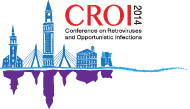Lower newborn bone mineral content with maternal tenofovir use
24 March 2014. Related: Conference reports, Pregnancy, CROI 21 (Retrovirus) 2014.
Polly Clayden, HIV i-Base
 Maternal tenofovir disoproxil fumarate (TDF) use is associated with a significant reduction of bone mineral content in neonates in a multisite study from the United States and Puerto Rico.
Maternal tenofovir disoproxil fumarate (TDF) use is associated with a significant reduction of bone mineral content in neonates in a multisite study from the United States and Puerto Rico.
TDF is currently recommended for pregnant women in BHIVA, US DHHS and WHO guidelines. Little is known about the effect on infant bones with this strategy.
George Siberry from the NIH presented findings from a study conducted to compare the bone mineral content of newborns exposed and not exposed to TDF in utero.
This research was part of the SMARTT (Surveillance Monitoring of ART Toxicities) component of the PHACS (Pediatric HIV Cohort Study). HIV positive women are enrolled during pregnancy and their uninfected infants at 0 to 2 weeks.
The TDF substudy enrolled two groups of HIV-exposed, uninfected newborns of at least 36 weeks gestational age (infected infants were excluded) at 14 US and 9 Puerto Rican sites. The TDF group included infants whose mothers received this drug for eight weeks or more in the third trimester. The non-TDF group included infants whose mothers did not receive TDF in pregnancy at any time.
A whole body dual-energy X-ray absorptiometry (DXA) was performed within four weeks of birth to measure bone mineral content of the infant and analysed with and without including the head. Analysis of the scans was standardised and conducted centrally.
The study had 80% power to detect a mean difference of 7% or 0.5 standard deviations of bone mineral content between arms. This gave a target sample size of 75 to ensure at least 63 evaluable per arm. Dr Siberry noted that the study did not depend on defining bone mineral content as normal or abnormal as there are no such infant norms available.
There were 74 evaluable infants in the TDF and 69 in the non-TDF group. TDF use among the mothers varied by site, p<0.001. Mothers in the TDF group were more likely to be married, 31% vs 22%, p=0.04 and to have received boosted protease inhibitors, 86% vs 64%, p=0.005. Otherwise the groups were similar for demographics, infant weight z-score, p=0.38, length z-score, p= 0.21) and gestational age, p=0.6. In the third trimester similar proportions of mothers with available data had CD4 >250 cells/mm3 and viral load <400 copies/mL in each group.
The most widely used regimens in the TDF group were TDF/FTC/boosted atazanavir (52%) and TDF/FTC/boosted darunavir (16%). AZT/3TC/boosted lopinavir (41%) and AZT/3TC/abacavir (21%) were most widely used in the non-TDF group.
The unadjusted mean infant whole body bone mineral content was 7.9 g lower (12.2%, 0.5 SD; p=0.002) in the TDF group: 56 g vs 63.8 g. The effect persisted in the multivariate model (adjusted for site, infant gestational age, body length, ethnicity, age at DXA; maternal boosted PI use, age and smoking) whole body bone mineral content was 6.4g (95% CI 2.1 to 10.7) lower in the TDF group, p=0.004. Results were similar when whole body bone mineral content did not include the head in the analysis.
Dr Siberry noted that maternal CD4 and viral load were unlikely to have a role in mediating this association as these values were similar in each group and the investigators found no link to infant body mineral content.
He suggested that the study was limited as it was non-randomised with possible residual confounding including PI use and high rates of triple NRTIs in the non-TDF group. The advantages are that the children will be followed up for years to come as part of SMARTT.
comment
The big question – asked after the presentation – is what to do with these data? Dr Silberry stressed that these results alone are not enough to change current recommendations for TDF use in pregnancy. “But this is the first study to address long standing concerns about the effect of maternal TDF on infant bones and provides some evidence that these concerns might have been well placed”, he said. He suggested that results from longitudinal studies are needed to better understand this phenomenon.
As well as continued follow up in SMARTT, a substudy of the IMPAACT 1077 PROMISE maternal and infant survival trial (IMPAACT P1084S) is looking at the effects of TDF on the bone and kidneys of HIV positive women during pregnancy and breastfeeding. [2]
The study will also look at bone health and kidneys in the infants of these women and includes several sites in Africa. It is randomised to compare TDF exposed and unexposed infants and results should be available in 2016.
References
- Siberry et al. Lower newborn bone mineral content associated with maternal use of tenofovir disoproxil fumarate. 21st CROI. 3-6 March 2014. Boston. Oral abstract 71.
http://www.croiwebcasts.org/console/player/22145 - Clinical trials.gov. Study of effects of tenofovir on bone health and kidneys during pregnancy and breastfeeding.
http://clinicaltrials.gov/ct2/show/NCT01066858

